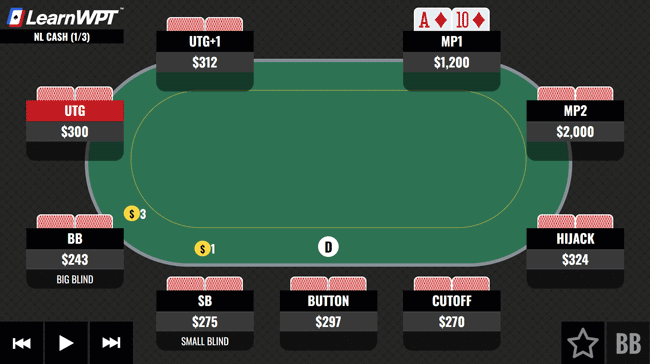Poker Quiz! A♦T♦ Facing a Large Turn Bet, What Do You Do Here?
DECISION POINT: You are in a live $1/$3 cash game with most stacks at $300, except for you with $1200, and the player on your direct left with $2000. The UTG+1 player limps, you raise to $20 from MP1 with A♦T♦, MP2 raises to $55 and only you call. On the A♠Q♣K♣ flop you check, Villain bets $55 and you call. The turn is the 7♥, you check and your opponent bets $150.
What do you do here?
PRO ANSWER: We are playing a low stakes $1/$3 live cash game. Most of the stacks around the table are $300 but we’ve managed to amass a $1200 stack and the player to our direct left is sitting with $2000 and has us covered. We are dealt AdTd in MP1. The Under the Gun player folds and UTG+1 open limps.
In most lower stakes games you will observe players limping with fairly wide ranges from all positions. Against opponents who are tricky and capable of limping big hands with the plan of reraising opponents that raise and attempt to isolate the limper, we could opt to just limp behind here and play our suited ace speculatively. However, against players who limp with a high frequency vs raising first-in this is a great spot to make an isolation raise and attempt to play heads-up in position against a loose player with a weak, capped range. In game we raised to $20 and the MP2 player next to act with a covering stack raises to a total of $55. The remaining opponents fold and action is back on us.
This decision is much closer than it may appear in the outset. MP’s reraise of our open to $20 seems quite strong as there are still 5 players remaining to act behind. However, given the deep effective stacks (just over 400BB), our hand does have some substantial implied odds postflop so we elect to make the call.
The flop is AsKcQc. Given we chose to defend the raise by calling, by default we check to the preflop raiser. The player in MP2 makes a continuation bet of $55, or about half pot. We have flopped some equity in this spot with top pair and an inside straight draw. Facing a very tight opponent who would only 3-bet premium hands preflop we would actually be fine making an exploitative fold here. Against solid opposition that is capable of 3-betting with an appropriately polarized range preflop folding to this c-bet would be a mistake so we call.
Continued below...
The turn is the 7h. We check and our opponent bets $150. When we analyze this turn spot using a solver there are two main points of contention. Preflop the solver mostly calls, but does fold some combinations that show a neutral EV. On the turn the solver prefers folding and there are a few combinations with a neutral EV that call. The flop analysis strongly prefers calling based on GTO solutions. However, these results should be taking into account factors that might be unique to the game and not easily be accounted for when running the simulation.
The solver assumes that our opponents are 3-betting appropriately polarized ranges preflop that include some Kxs/99/76s hands for balance that some of our real world opponents may not 3-bet in real world games. Even when there are some of these combinations in an opponent’s range, it’s highly likely they are not used in appropriate frequency to be balanced. If we remove many of these types of hands from MP2’s range our strategy should adjust by continuing with a narrower range both preflop and postflop.
If we decided to fold preflop or on the flop using the justification that our opponents are using narrower 3-betting ranges than as dictated by GTO play we would be correct.
Against a solid, GTO opponent though, calling both the preflop raise and the c-bet is correct, while the turn is a clear fold.
Folding is the correct play.
How would you play it?
Share your answer in the comments below!
Train → Play → Think → Like a Pro
We created LearnWPT with the goal to provide a place that empowers players to ask questions, help get them focused, and provide a solid game-plan to bring to the table every time they sit down.
Some of the ways we accomplish this is by:
- Teaching and presenting examples of proven, winning concepts through our Strategy Episodes (short 10-15 min videos)
- Having Members Practice, Drill, and Play Hands using the WPT GTO Trainer for instant feedback on their decisions
- Providing a place where Members can send questions to receive answers and guidance with the Ask a Pro Forums
- Giving Members the ability to record and send hands they've played to receive expert analysis using the Hand Input Tool
Not a Member? Click below to join (just $5 your first month) and start improving your game today!

